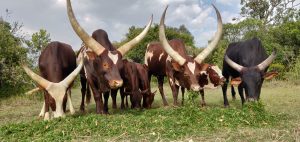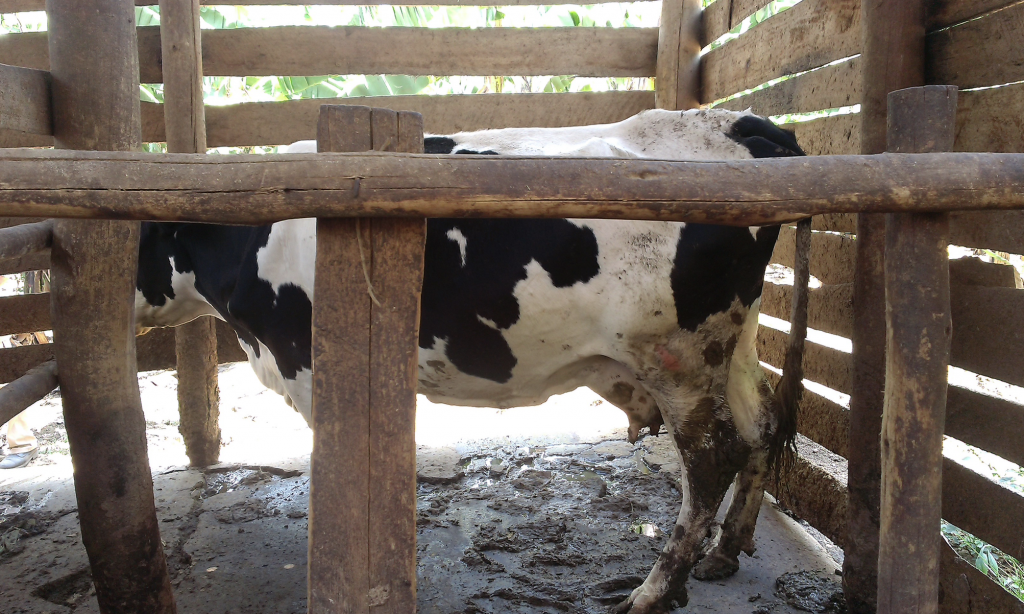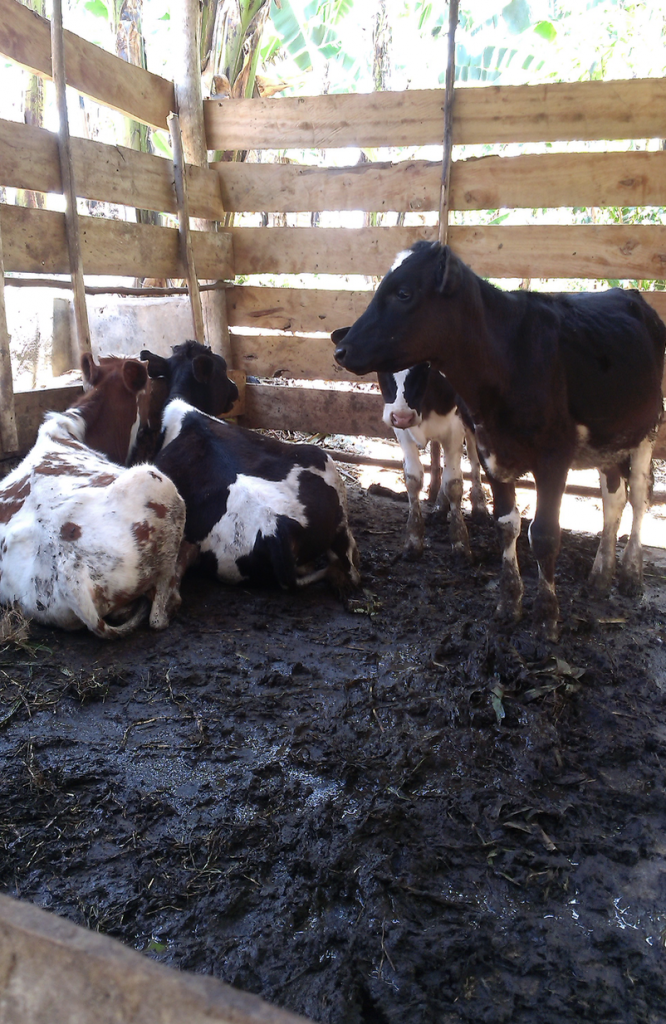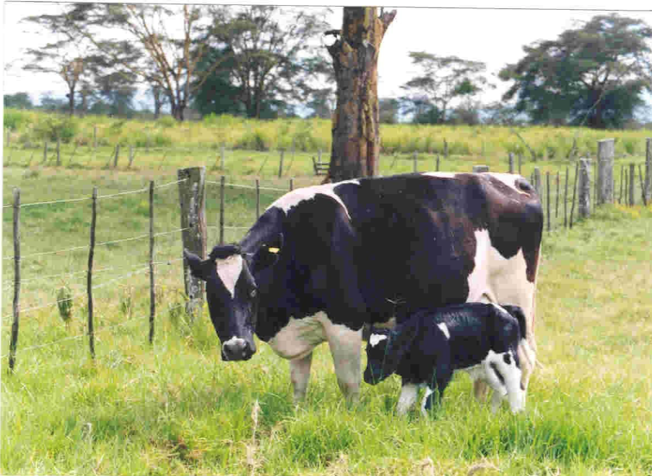Cattle Welfare
Credits: Biovision-Infonet

Credit: Su Kahumbu
Understand Cattle and promote their Health and Welfare
Cattle have a history of domestication for thousands of years. Many different breeds are developed and adapted to highly different environments and conditions throughout the world. They are natural grazers and their digestion is totally geared towards grazing and eating roughage. They will graze and ruminate most of the day. When grazing, they will stand with one front leg a little in front of the other, and graze as they slowly walk forward. They do not naturally walk backwards, and therefore most bed and cubicle systems force them to unnatural movements for their anatomy. They are remarkably strong and robust animals, and if a trustful relationship with humans is created, they are friendly, patient and collaborative towards humans. Since they are strong, they can cause a lot of damage if they are scared and confused, which is often due to mistreatment or lack of guidance on what they should do. They do not want to walk from light to darkness, they prefer to walk uphill rather than downhill, and they do not want to walk around sharp corners.

They get easily scared if they see unknown things, like cloth blowing in the wind. Their walkway and housing systems should be designed to meet these needs for them to feel safe and comfortable. The humans should take the time which the cattle need to walk in their own pace – otherwise the risk of lameness gets high. Cattle have a vivid body language, which we as humans can read. They use their tails in their communication: when it is hanging down, it is relaxed, and when it is in between the hind legs, it is scared or cold or in pain. When alert, it raises its tail. The ears and head movements clearly shows their mood: curious, angry, scared etc.

Cattle have a good sight, but a blind angle behind them – therefore they should always be approached slightly from the side to not get startled.
They need space to ‘swing’ their body when laying down or raising up. This space should always be provided when designing housing facilities. An adult cow uses about 3 meters to get up or lay down. The movement forward with the head and shoulders alone is about 0.7-1 meter.

Cattle are clean animals. They prefer to not step in their own manure, they have an instinct that they should graze in a distance from dung to avoid parasites, which can be transferred through manure. For their personal skin hygiene, they groom each other, and they can reach all parts of their own body. To do this, they should always have a non-slippery floor to stand on. This is also necessary when they show that they are in heat, because then other cows or the bull will approach them and jump on their back (the sign for the owner that they are in heat), and they can damage themselves severely if the floor does not allow safe jumping.

(c) AIC Documentation Unit, Kenya
Much of their behavior can be explained by the fact that they are flock animals. This means that they perform synchronic behavior: they want to do the same things at the same time, and stay in the group. They graze and lay down as a group. One cow is not likely to leave the group, unless she is diseased or expecting to calve.
Cattle health and welfare are two very important aspects of dairy production.
Many losses in dairy cattle production can be avoided by paying careful attention to preventive health care and seeing that the animals are comfortable and able to function the way nature intended. The following are the main preventive measures every serious dairy farmer should consider:
- Proper feeding and prevention of starvation is the first aspect to be addressed
- Disease prevention such as regular tick control
- Prevention of management and production diseases
- Vaccination of animals according to veterinary recommendations for the area
- Good housing/ milking facilities, where proper hygiene can be managed
- Good supervision to ensure incidental diseases are dealt with in a timely and appropriate manner
Below, some additional points add to the understanding of cows and how they can be supported by good management in a farming environment:
1. Hunger and thirst
Cows spend 7-9 hours a day grazing and nearly the same amount of time ruminating the ingested feed. Adequate provision of fibre is an essential requirement for a healthy rumen environment. Fibre ranging from 7-10 cm in length (approximately the width of the muzzle) is optimum and prevents cattle selecting through the ration and discarding longer fibre. Long fibre stimulates cudding, which in turn stimulates saliva production, and saliva is the primary rumen buffer, preventing acidosis. The optimum forage to concentrate ratio to maintain rumen health and pH at 6 – 6.8 is 60:40 on a dry matter (DM) basis (roughage: concentrate). Rumen acidosis is the most common forage related stress that we see in dairy cattle. Rumen acidosis is primarily due to inadequate levels of effective fibre in the rations of those cows. High yielding cows are commonly fed diets containing 45 – 55 % forage on a DM basis. Finishing beef cattle are often fed a diet consisting of 25 – 40% forage on a DM basis.
2. Freedom from discomfort
A long lying period and space to move freely, lying and raising up, and escaping in cases of confrontations is important in the prevention of lameness in dairy cows, and it has also been noted that cows spend significantly more time lying down ruminating, as opposed to standing ruminating. Because a large percentage of cattle time is spent ruminating whilst loafing, dry comfortable hygienic bedding that encourages cows to lie down is highly important.
3. Freedom from pain, injury or disease
Hygienic bedding material in order to minimize the risk of mastitis is a priority. Being able to lie down is very important to cattle. When given choice and optimum conditions, cows are known to spend 50% or more of their time lying down. A comfortable resting surface is an important aspect in encouraging cows to lie down. Cattle prefer dry, soft, insulating bedding, and subsequently show reduced incidence and severity of leg injuries.In addition, the following need to be adhered to:
- Stocking Rate: A stocking rate of 1 to 1.4 Lu’s/ha is suitable for organic farming. ( Lu= Livestock Unit)
- Livestock System: Suckler cows and sheep are suited to organic farming. Under good husbandry natural immunity to parasites and diseases can develop. A grazing system which reduces the worm burden should be established.
- Clover: Clover is essential at higher stocking rates. Good clover stands can double pasture production, grass quality and animal performance is improved.
- Tillage: Some tillage is a major bonus. It provides cheaper grain and straw and allows the renewal of grassland. From 2008 only organic cereals can be fed to ruminants.
- Housing: The conventional straw bedded sheep house conforms to organic standards. In cattle housing a straw bedded lying area is essential (the feeding area may be slatted).